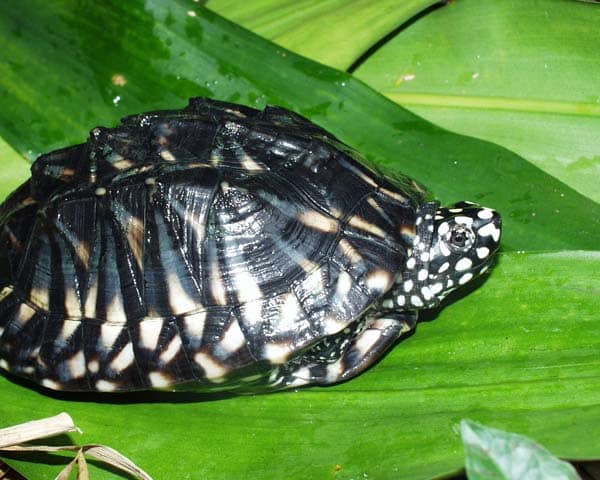Care sheet for the spotted pond turtle (Geoclemys hamiltonii).
Spotted Pond Turtle (Geoclemys hamiltonii)
Baby and juvenile spotted pond turtles are truly one of the world’s most beautiful turtles. Though difficult to obtain – they are protected as both a CITES Appendix I and Endangered Species – they are nonetheless being captive bred in large numbers, mostly in California and Florida. Well-acclimated adults in proper enclosures are proving to be very prolific, and the captive-hatched babies have proven to be hardy captives.
Spotted pond turtles are found in large, deep rivers in northern India, Assam, southern Pakistan and Bangladesh. They are active baskers and can be seen catching rays on partially submerged logs, rocks, and even the edges of riverbanks. In nature they feed on fish, invertebrates and floating aquatic plants.
Spotted Pond Turtle Availability
The spotted pond turtle received protection from CITES and the Endangered Species Act (ESA) in 1976, and importation was banned. Luckily, a few were in private hands in the United States and in Europe, and under watchful eyes these turtles have thrived. One population in Florida has produced several hundred babies over the last 10 years.
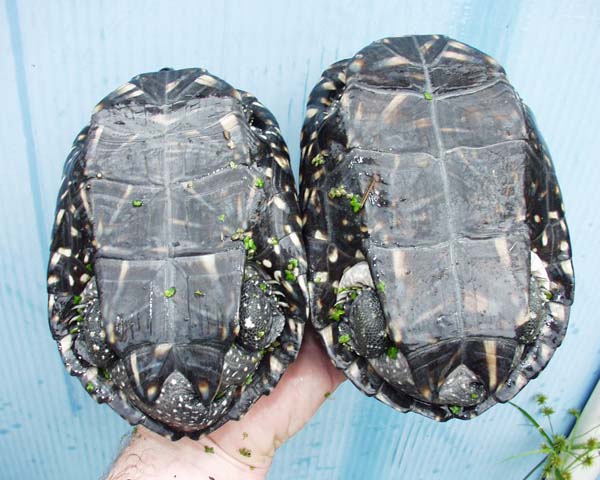
Photo Credit: Russ Gurley
An adult male, left, and an adult female spotted pond turtle.
Sadly, even captive-hatched babies cannot be shipped out of the state where they were produced (as a commercial transaction) without a Captive Born Wildlife Permit. This permit is fairly easy to obtain, but both parties in the transaction – both buyer and seller – must have one or the turtles cannot be shipped across state lines. Babies and adults can be transported across state lines if the transaction is not commercial, such as a gift or breeding loan, but this transaction will be scrutinized heavily by U.S. Fish and Wildlife, and any attempt to skirt the law is usually dealt with harshly.
Spotted Pond Turtle Adult Size
Adult female spotted pond turtles average 11 to 12 inches in total length; males are smaller, usually 7 to 8 inches. As with most turtles, males have longer, thicker tails than females. The males do not have concave plastrons, as are seen in some other species of turtles.
Spotted Pond Turtle Life Span
Spotted pond turtles can live 15 to 20 years or more if cared for properly.
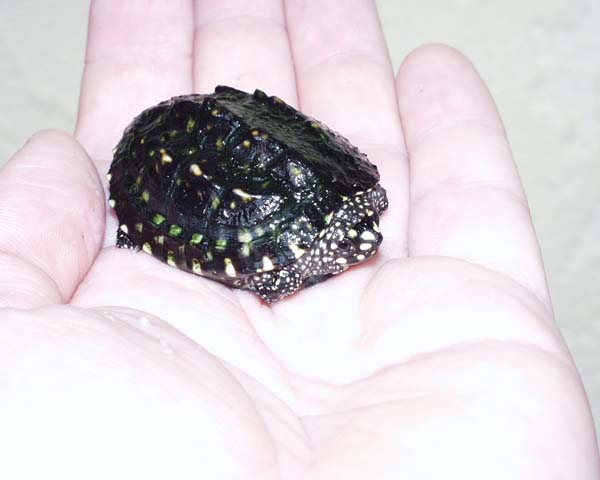
Photo Credit: Russ Gurley
Spotted pond turtle hatchling.
Spotted Pond Turtle Captive Care
Spotted pond turtles do very well in outdoor ponds in warmer climates. They do not cool down much in their natural habitats, and in all but the coldest environments they are alert and active year-round. They are sun worshippers, so provide plenty of branches and rock piles for them to climb out and bask.
Indoors, a basic setup with a deep water section and basking area in a large tub or stock tank (at least 6 feet long by 3 feet wide by 3 feet deep or more) will be sufficient to hold a pair of adult turtles. Remember that a spotted pond turtle reaches an adult size comparable to a football. An efficient filtration system is highly recommended.
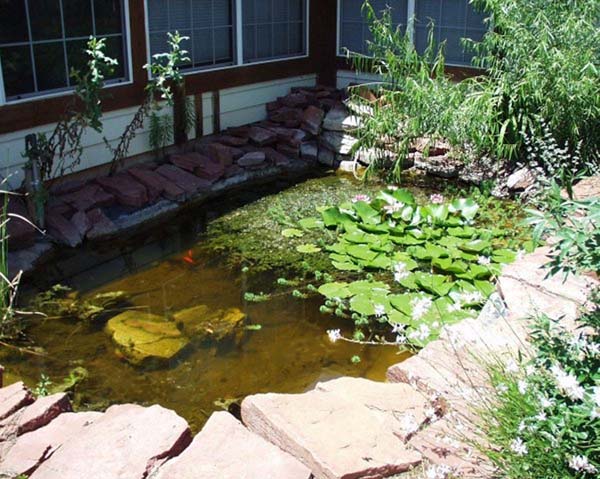
Photo Credit: Russ Gurley
Spotted pond turtle pond.
Spotted Pond Turtle Lighting and Temperature
Place a shop light fixture with UVB-emitting bulbs over the spotted pond turtle enclosure, and mount a 100-watt spotlight to create a basking spot of 95 degrees Fahrenheit. Air temperature in the enclosure should be between 75 and 80 degrees. Use a 250-watt submersible heater to maintain the water temperature at 78 to 80 degrees. Depending on the indoor air temperatures, an additional heat light may be required at night or during the day so the turtles can thermoregulate to raise their body temperature to optimal levels for digestion.
Exposure to natural sunlight or UVB light allows turtles to produce vitamin D3, which is critical in allowing a turtle’s body to absorb and use available calcium. Fluorescent bulbs made especially for use with reptiles can provide UVB, as can mercury vapor bulbs, which also provide some heat. If fluorescent tubes are used for UVB, a separate light may be required for heat.
Spotted pond turtles can handle a wide range of temperatures if kept outdoors, but once temperatures drop into the 50s at night, or if daily high temperatures fail to exceed 60 degrees, move the turtles indoors or provide supplemental heat. Be careful when placing turtles outside. Glass enclosures such as aquariums heat up quickly in the sun, killing pet turtles in a matter of minutes. Also, predators such as birds, cats, dogs, and even ants can attack and kill your spotted pond turtle.
Spotted Pond Turtle Food
Spotted pond turtles are carnivorous, eagerly consuming fish, worms, crickets and floating turtle food. I offer mine a combination of two or three commercial turtle foods three times a week. I also offer fish, worms and even thawed pink mice once or twice a week to add some variety. Respect your turtles’ need for a balanced and varied diet, and they will grow into beautiful, healthy adults.
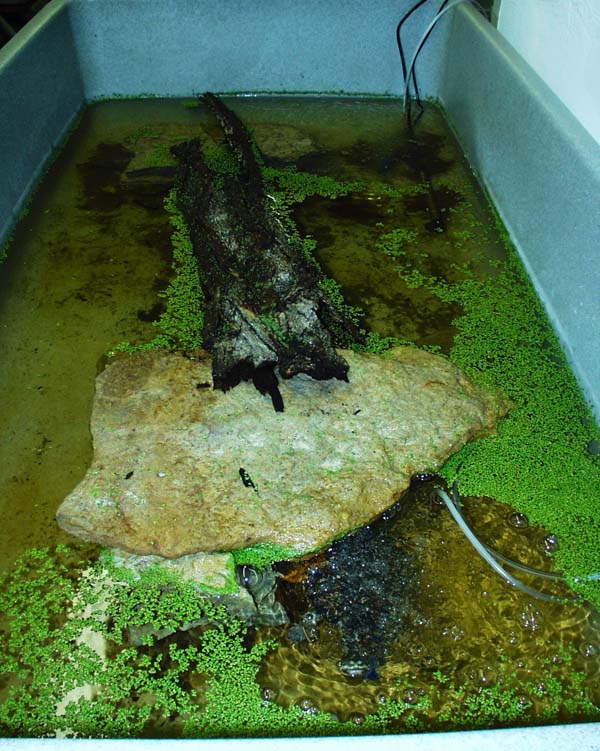
Photo Credit: Russ Gurley
Spotted pond turtle juvenile enclosure.
Spotted Pond Turtle Health
Spotted pond turtles are only available as captive-hatched babies, so their health issues are few. These are hardy, alert and energetic turtles. They seem to thrive in a variety of water conditions. Their need for warm water and an intense basking area is important, and of course a healthy diet will help keep health issues to a minimum. Poor water quality and improper temperatures will result in turtles with eye problems and respiratory issues that will lead to expensive veterinary visits and, potentially, the death of the turtle.
Spotted Pond Turtle Breeding
Captive breeding of G. hamiltonii is simple and straightforward. Adults breed throughout the spring and a female will typically lay two clutches of six to 10 eggs each year. The eggs should be incubated in an incubator at 82 to 84 degrees. Hatchlings appear after 60 to 65 days.
Hatchlings thrive in a warm environment with clean, filtered water. They can be kept in a 20-gallon long aquarium or similarly sized enclosure (20 inches long by 12 inches wide by 12 inches tall), with an external filter, basking spot, heat and UVB-emitting lamps overhead, and a few live aquatic plants, both floating and submerged. They will feed on a wide variety of insects, insect larvae and small fish, in addition to two or three turtle food pellets each day. I suggest a mix of pellets that contain fish, krill and Spirulina algae.
Spotted Pond Turtle Handling and Temperament
Although over time spotted pond turtles learn to recognize their keepers and may come to them for food, most aquatic turtles are not good pets for young children and should be handled infrequently. Young turtles are shy and will spend a great deal of time hiding in aquatic plants and beneath submerged rock caves and logs. Aquatic turtles can also be quite expensive to set up and maintain, as they need large enclosures, filtration equipment, water conditioners, and they require frequent water changes and monitoring of their captive conditions.
When established properly, a creative enclosure of spotted pond turtles can be a beautiful and exciting addition to a home environment. Imagine one of the most beautiful turtles in the world in your home, in a shining aquarium with clean fresh water and lush aquatic plants, and having it thrive under your attentive care!
Additional Reading
Basu, D. and P. Singh. 1998. “Reproduction in the spotted pond turtle.” Hamadryad, 23(2):157-161.
Das, I. 1985. Indian turtles, a field guide. World Wildlife Fund.
Das, I. 1991. Colour Guide to the Turtles & Tortoises of the Indian Subcontinent. R&A Publishing Limited.
Das, I. 1995. Turtles and Tortoises of India. Oxford University Press.
Gurley, R. 2005. Keeping and Breeding Freshwater Turtles. Living Art Publishing.
Hill, W. and D. Lee. 2011. “Husbandry and Captive Breeding of the Spotted Pond Turtle, Geoclemys hamiltoni.” The Batagur, 1(1): 9-14.
Pritchard, P. 1979. Encyclopedia of Turtles. T.F.H. Publications.
Rashid, S. M. A. and I. R. Swingland. 1997. “On the Ecology of Some Freshwater Turtles in Bangladesh,” in Proceedings: Conservation, Restoration, and Management of Tortoises and Turtles – An International Conference, pp. 225-242. New York Turtle and Tortoise Society.
Russ Gurley is the director of the Turtle and Tortoise Preservation Group. To learn more about turtles and tortoises, visit the TTPG website at www.ttpg.org. To purchase books about turtles and tortoises and their care and conservation, visit Russ’s website at www.livingartpublishing.com.

